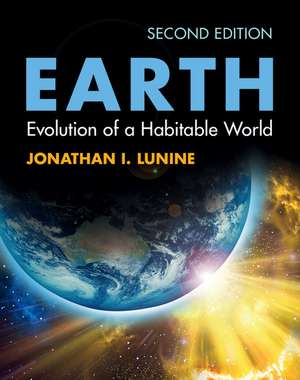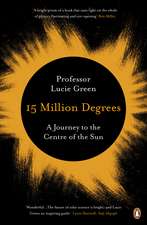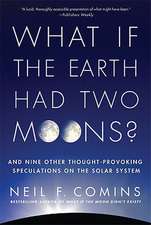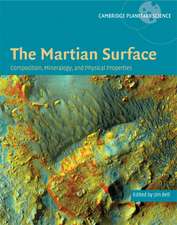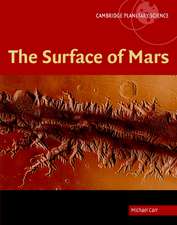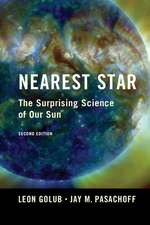Earth
Autor Jonathan I. Lunineen Limba Engleză Paperback – 7 apr 2013
Preț: 566.15 lei
Preț vechi: 636.12 lei
-11% Nou
Puncte Express: 849
Preț estimativ în valută:
108.33€ • 113.41$ • 89.64£
108.33€ • 113.41$ • 89.64£
Carte disponibilă
Livrare economică 17-31 martie
Preluare comenzi: 021 569.72.76
Specificații
ISBN-13: 9780521615198
ISBN-10: 0521615194
Pagini: 327
Ilustrații: 80 b/w illus. 10 colour illus. 10 tables 100 exercises
Dimensiuni: 215 x 273 x 17 mm
Greutate: 0.98 kg
Ediția:Revizuită
Editura: Cambridge University Press
Colecția Cambridge University Press
Locul publicării:Cambridge, United Kingdom
ISBN-10: 0521615194
Pagini: 327
Ilustrații: 80 b/w illus. 10 colour illus. 10 tables 100 exercises
Dimensiuni: 215 x 273 x 17 mm
Greutate: 0.98 kg
Ediția:Revizuită
Editura: Cambridge University Press
Colecția Cambridge University Press
Locul publicării:Cambridge, United Kingdom
Cuprins
Preface; Acknowledgements; Part I. The Astronomical Planet: 1. An introductory tour of Earth's cosmic neighbourhood; 2. Largest and smallest scales; 3. Forces and energy; 4. Fusion, fission, sunlight, and element formation; Part II. The Measurable Planet: Tools to Discern the History of Earth and the Planets: 5. Determination of cosmic and terrestrial ages; 6. Other uses of isotopes for Earth history; 7. Relative age dating of cosmic and terrestrial events: the cratering record; 8. Relative age dating of terrestrial events: geologic layering and geologic time; 9. Plate tectonics: an introduction to the process; Part III. The Historical Planet: Earth and Solar System through Time: 10. Formation of the solar system; 11. The Hadean Earth; 12. The Archean eon and the origin of life: i. Properties of and sites for life; 13. The Archean eon and the origin of life: ii. Mechanisms; 14. The first greenhouse crisis: the faint early sun; 15. Climate histories of Mars and Venus, and the habitability of planets; 16. Earth in transition: from the Archean to the Proterozoic; 17. The oxygen revolution; 18. The Phanerozoic: flowering and extinction of complex life; 19. Climate change across the Phanerozoic; 20. Toward the age of humankind; Part IV. The Once and Future Planet: 21. Climate change over the past 100,000 years; 22. Human-induced global warming; 23. Limited resources: the human dilemma; 24. Coda: the once and future Earth; References; Index.
Recenzii
'The keenly awaited second edition of Lunine's book does not disappoint. The clarity of writing and level of scholarship remain high, and there is no other treatment of our planet with this interdisciplinary breadth. As we home in on Earth-like worlds far from home, this book is a perfect component for an undergraduate astronomy or astrobiology course.' Chris Impey, University Distinguished Professor, University of Arizona
'Lunine focusses on the Earth as a system, and sets it in context in comparison with other Solar System bodies. This is how a geoscience text should be done these days.' David A. Rothery, The Open University
'Earth: Evolution of a Habitable World brings the knowledge gained by 50 years of Solar System exploration back to Earth and infuses the often hazy first half of Earth history with new energy and insight, providing a unique perspective on the entire history of our home planet.' James Head, Louis and Elizabeth Scherck Distinguished Professor of Geological Sciences, Brown University
'Lunine's astrobiological perspective on Earth history is a breath of fresh air, drawing on the entire breadth of science to address fundamental questions about the origins of life, and the development of the systems that sustain it here on Earth, in a manner that quickly and directly connects to students.' Marshall Bartlett, Chair of Physics, Hollins University
'… I've never seen anything quite like it … This would be a spectacular text for a course providing a perspective on Earth and planetary science and modern issues in our stewardship of the Earth for students majoring in fields outside the geosciences … It could even give geology students perspective on the 'deep time' that is beyond the vast majority of Earth's geologic record, and on Earth's place in the solar system … Jonathan Lunine is a scientist who knows his planetary climates, having studied atmospheres of worlds inside and outside our solar system, and who has done lots of recent work on astrobiology.' Emily Lakdawalla, The Planetary Society (planetary.org)
'Earth: Evolution of a Habitable World succeeds remarkably in providing a well-balanced, enjoyable, and crystal clear summary of a broad set of topics that together introduce Earth and life in its complexity and interconnectedness. The book is rich in up-to-date research and it simultaneously provides a breadth and depth that are unmatched - students, interested laymen, and researchers will all enjoying reading it. What set[s] Lunine's text apart from the increasing number of great astrobiology books [is] the unmatched clarity of the text, its logical and well-balanced structure, and the surprising level of detail that the book succeeds in providing over the breadth of topics covered. Earth: Evolution of a Habitable World is an excellent book for geosciences, planetary sciences, and astrobiology - it is set to be a classic, like its first edition was.' Daniel Apai, Meteoritics and Planetary Science
'When this book arrived for review and I scanned the contents my first thought was, 'This looks like a great asset to my current OU studies …' and by and large I have to say it has been a good companion. … well structured and easy enough to read … I enjoyed this book …' David Swain, Open University Geological Society Journal
'Lunine always shows us the exact nature of the evidence that leads scientists to be able to piece together the jigsaw puzzle they are trying to solve. He does this with careful referencing and good use of figures, so that the interested reader will always know where to look up more information, or investigate the data more deeply themselves.' Vijay Tymms, New Directions
'I marvelled at the huge scope of science, and the amount of integration of different fields that astrobiologists have achieved. This book would be extremely useful to anyone with gaps in their astrobiology knowledge; if the book does not completely fill them, it will certainly point you to other sources that can. … It is a mine of treasure in references and scientific leads, and it also highlights areas that are not yet fully understood, where more research can be undertaken. I definitely recommend it to all who want to know more about how we can study astrobiology, and also to the nonmathematical, for while we do meet a few equations and methods, they are kept as simple as possible.' Alice Sheppard, Astrobiology Society of Britain (www.astrobiologysociety.org)
'Lunine focusses on the Earth as a system, and sets it in context in comparison with other Solar System bodies. This is how a geoscience text should be done these days.' David A. Rothery, The Open University
'Earth: Evolution of a Habitable World brings the knowledge gained by 50 years of Solar System exploration back to Earth and infuses the often hazy first half of Earth history with new energy and insight, providing a unique perspective on the entire history of our home planet.' James Head, Louis and Elizabeth Scherck Distinguished Professor of Geological Sciences, Brown University
'Lunine's astrobiological perspective on Earth history is a breath of fresh air, drawing on the entire breadth of science to address fundamental questions about the origins of life, and the development of the systems that sustain it here on Earth, in a manner that quickly and directly connects to students.' Marshall Bartlett, Chair of Physics, Hollins University
'… I've never seen anything quite like it … This would be a spectacular text for a course providing a perspective on Earth and planetary science and modern issues in our stewardship of the Earth for students majoring in fields outside the geosciences … It could even give geology students perspective on the 'deep time' that is beyond the vast majority of Earth's geologic record, and on Earth's place in the solar system … Jonathan Lunine is a scientist who knows his planetary climates, having studied atmospheres of worlds inside and outside our solar system, and who has done lots of recent work on astrobiology.' Emily Lakdawalla, The Planetary Society (planetary.org)
'Earth: Evolution of a Habitable World succeeds remarkably in providing a well-balanced, enjoyable, and crystal clear summary of a broad set of topics that together introduce Earth and life in its complexity and interconnectedness. The book is rich in up-to-date research and it simultaneously provides a breadth and depth that are unmatched - students, interested laymen, and researchers will all enjoying reading it. What set[s] Lunine's text apart from the increasing number of great astrobiology books [is] the unmatched clarity of the text, its logical and well-balanced structure, and the surprising level of detail that the book succeeds in providing over the breadth of topics covered. Earth: Evolution of a Habitable World is an excellent book for geosciences, planetary sciences, and astrobiology - it is set to be a classic, like its first edition was.' Daniel Apai, Meteoritics and Planetary Science
'When this book arrived for review and I scanned the contents my first thought was, 'This looks like a great asset to my current OU studies …' and by and large I have to say it has been a good companion. … well structured and easy enough to read … I enjoyed this book …' David Swain, Open University Geological Society Journal
'Lunine always shows us the exact nature of the evidence that leads scientists to be able to piece together the jigsaw puzzle they are trying to solve. He does this with careful referencing and good use of figures, so that the interested reader will always know where to look up more information, or investigate the data more deeply themselves.' Vijay Tymms, New Directions
'I marvelled at the huge scope of science, and the amount of integration of different fields that astrobiologists have achieved. This book would be extremely useful to anyone with gaps in their astrobiology knowledge; if the book does not completely fill them, it will certainly point you to other sources that can. … It is a mine of treasure in references and scientific leads, and it also highlights areas that are not yet fully understood, where more research can be undertaken. I definitely recommend it to all who want to know more about how we can study astrobiology, and also to the nonmathematical, for while we do meet a few equations and methods, they are kept as simple as possible.' Alice Sheppard, Astrobiology Society of Britain (www.astrobiologysociety.org)
Descriere
Fully updated, this new edition provides a uniquely interdisciplinary overview of Earth's history and evolution for Earth science undergraduates.
